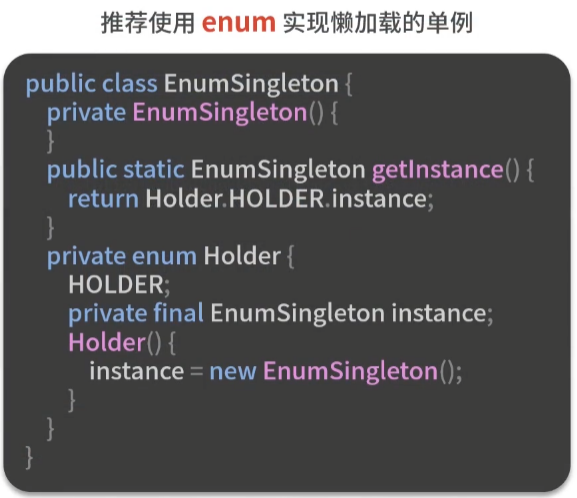参考资料1:http://c.biancheng.net/design_pattern/
参考资料2:https://refactoringguru.cn/design-patterns/catalog
01. 单例设计模式
- 作用
- 在java virtual machine(JVM)中只创建一个实例
- 分类
- 饿汉单例设计模式
- 懒汉单例设计模式
- 同步懒汉单例设计模式
- 双重锁校验单例设计模式
- 静态内部类单例设计模式
- 枚举单例设计模式 -
推荐
- ThreadLocal线程单例
1.1 饿汉式-推荐
步骤
- 私有化构造器
- 在本类中声明一个本类对象,并使用private static修饰
- 给本类对象提供一个get方法
代码实现
1
2
3
4
5
6
7
8
9
10
11
12
13
14
15
16
17
18
19
| public class TestSingleton {
public static void main(String[] args) {
Singleton1 s1 = Singleton1.getInstance();
Singleton1 s11 = Singleton1.getInstance();
System.out.println(s1);
System.out.println(s11);
}
}
class Singleton1 {
private static final Singleton1 instance = new Singleton1();
private Singleton1() {}
public static Singleton1 getInstance() {
return instance;
}
}
|
1.2 懒汉式
- 步骤
- 私有化构造器
- 在本类中创建一个本类引用,并使用private static修饰
- 给本类对象提供一个get方法
- 代码实现
1
2
3
4
5
6
7
8
9
10
11
12
13
14
15
16
17
18
19
| public class TestSingleton {
public static void main(String[] args) {
Singleton2 s2 = Singleton2.getInstance();
Singleton2 s22 = Singleton2.getInstance();
System.out.println(s2);
System.out.println(s22);
}
}
class Singleton2 {
private static Singleton2 instance = null;
private Singleton2() {}
public synchronized static Singleton2 getInstance() {
return instance == null ? instance = new Singleton2() : instance;
}
}
|
饿汉和懒汉的区别:
- 饿汉
- 效率高
- 线程安全
- 不支持懒加载(lazy load)
- 懒汉
- 懒加载
- lazy load ,当一个资源被使用时才加载,不使用时不加载。
- 区别
- 饿汉是以空间换时间(执行效率相对高些),懒汉是以时间换空间(执行效率相对低些)
- 饿汉是线程安全的,懒汉是线程不安全的。(有所谓!!!)
- 饿汉不支持懒加载,懒汉支持懒加载
1.3 同步懒汉式
1
2
3
4
5
6
7
8
9
10
11
12
13
| public class MySingleClass03 {
private MySingleClass03(){}
private static MySingleClass03 instance = null;
public static MySingleClass03 getInstance() {
synchronized (MySingleClass03.class) {
if (instance == null) {
instance = new MySingleClass03();
}
}
return instance;
}
}
|
1.4 双重锁校验式-面试常见
1
2
3
4
5
6
7
8
9
10
11
12
13
14
| public class MySingleClass04 {
private MySingleClass04(){}
private volatile static MySingleClass04 instance = null;
public static MySingleClass04 getInstance() {
if (null == instance) {
synchronized (MySingleClass04.class) {
if (instance == null) {
instance = new MySingleClass04();
}
}
}
return instance;
}
}
|
1.5 静态内部类式
- 步骤
- 私有化构造器
- 声明一个静态内部类
- 初始化单例对象,并使用private final static修饰
- 提供一个get方法
- 代码实现
1
2
3
4
5
6
7
8
9
10
11
12
13
14
15
16
17
18
19
20
21
22
23
24
| public class TestSingleton {
public static void main(String[] args) {
Singleton3 s3 = Singleton3.getInstance();
Singleton3 s33 = Singleton3.getInstance();
System.out.println(s3);
System.out.println(s33);
}
}
class Singleton3 {
private Singleton3() {}
public static final Singleton3 getInstance() {
return Holder.instancce;
}
private static class Holder {
private static final Singleton3 instancce = new Singleton3();
}
}
|
1.6 枚举式 - 推荐
枚举
- 在数学和计算机科学理论中,一个集的枚举是列出某些有穷序列集的所有成员的程序,或者是一种特定类型对象的计数。
- 就是一个天然的多例设计模式
枚举实现
1
2
3
| public enum SevenColor {
RED, ORANGE, YELLOW, GREEN, CYAN, BLUE, PURPLE
}
|
1
2
3
4
5
6
7
8
9
10
11
12
13
14
15
16
| public enum MySingleClass04 {
INSTANCE;
private Object data;
public Object getData() {
return data;
}
public void setData(Object data) {
this.data = data;
}
public static MySingleClass04 getInstance() {
return INSTANCE;
}
}
|

1
2
3
4
5
| MySingleClass04 instance01 = MySingleClass04.INSTANCE;
Constructor<MySingleClass04> c = MySingleClass04.class.getDeclaredConstructor();
c.setAccessible(true);
MySingleClass04 instance02 = c.newInstance();
System.out.println(instance01 == instance02);
|

- 通过查看 Enum 类的源码发现,枚举类是没有无参构造,再通过反射攻击有参构造器
- 反射攻击有参构造器
1
2
3
4
5
| MySingleClass04 instance01 = MySingleClass04.INSTANCE;
Constructor<MySingleClass04> c = MySingleClass04.class.getDeclaredConstructor(String.class, int.class);
c.setAccessible(true);
MySingleClass04 instance02 = c.newInstance("hello", 110);
System.out.println(instance01 == instance02);
|


结论
序列化攻击枚举单例设计模式
1
2
3
4
5
6
7
8
9
| MySingleClass04 instance01 = MySingleClass04.INSTANCE;
ObjectOutputStream oos = new ObjectOutputStream(new FileOutputStream("obj.obj"));
oos.writeObject(instance01);
oos.close();
ObjectInputStream ois = new ObjectInputStream(new FileInputStream("obj.obj"));
Object instance02 = ois.readObject();
ois.close();
System.out.println(instance01 == instance02);
|
1.7 ThreadLocal线程单例
1
2
3
4
5
6
7
8
9
10
11
12
13
14
15
| public class ThreadLocalSingleton {
private static final ThreadLocal<ThreadLocalSingleton> threadLocalInstance =
new ThreadLocal<ThreadLocalSingleton>() {
@Override
protected ThreadLocalSingleton initialValue() {
return new ThreadLocalSingleton();
}
};
private ThreadLocalSingleton() {}
public static ThreadLocalSingleton getInstance() {
return threadLocalInstance.get();
}
}
|
1
2
3
4
5
6
7
| public class ExectorThread implements Runnable {
@Override
public void run() {
ThreadLocalSingleton singleton = ThreadLocalSingleton.getInstance();
System.out.println(Thread.currentThread().getName() + ":" + singleton);
}
}
|
1
2
3
4
5
6
7
8
9
10
11
12
13
14
15
16
| public class TestSingleton {
public static void main(String[] args) {
System.out.println(ThreadLocalSingleton.getInstance());
System.out.println(ThreadLocalSingleton.getInstance());
System.out.println(ThreadLocalSingleton.getInstance());
System.out.println(ThreadLocalSingleton.getInstance());
System.out.println(ThreadLocalSingleton.getInstance());
Thread t1 = new Thread(new ExectorThread());
Thread t2 = new Thread(new ExectorThread());
t1.start();
t2.start();
System.out.println("End");
}
}
|

上面的单例模式为了达到线程安全的目的,给方法上锁,以时间换空间。ThreadLocal 将所有的对象全部放在 ThreadLocalMap 中,为每个线程都提供一个对象,实际上是以空间换时间来实现线程间隔离的。
02. 反射攻击单例设计模式
所学的单例设计模式
- 饿汉单例设计模式(推荐用)
- 懒汉单例设计模式
- 同步懒汉单例设计模式
- 双重锁单例设计模式(推荐用)
- 静态内部类单例设计模式(推荐用)
存在的问题
无法避免反射攻击
反射攻击单例设计模式
- 饿汉单例设计模式
- 双重锁单例设计模式
- 静态内部类单例设计模式
1
2
3
4
5
6
7
8
9
10
11
12
13
14
15
16
17
18
19
20
21
22
23
24
25
26
27
|
MySingleClass01 instance01 = MySingleClass01.getInstance();
Constructor<MySingleClass01> c1 = MySingleClass01.class.getDeclaredConstructor();
c1.setAccessible(true);
MySingleClass01 instance02 = c1.newInstance();
System.out.println(instance01 == instance02);
System.out.println("------------------------------");
MySingleClass02 instance03 = MySingleClass02.getInstance();
Constructor<MySingleClass02> c2 = MySingleClass02.class.getDeclaredConstructor();
c2.setAccessible(true);
MySingleClass02 instance04 = c2.newInstance();
System.out.println(instance03 == instance04);
System.out.println("------------------------------");
MySingleClass03 instance05 = MySingleClass03.getInstance();
Constructor<MySingleClass03> c3 = MySingleClass03.class.getDeclaredConstructor();
c3.setAccessible(true);
MySingleClass03 instance06 = c3.newInstance();
System.out.println(instance05 == instance06);
|
1
2
3
4
5
6
7
8
9
10
11
12
13
14
| public class MySingleClass01 {
private MySingleClass01(){
System.out.println("饿汉");
if (null != instance) {
throw new RuntimeException("已经存在对象了!");
}
}
private final static MySingleClass01 instance = new MySingleClass01();
public static MySingleClass01 getInstance() {
return instance;
}
}
|
1
2
3
4
5
6
7
8
9
10
11
12
13
14
15
16
17
18
19
20
21
22
| public class MySingleClass02 {
private MySingleClass02(){
System.out.println("双重锁");
if (null != instance) {
throw new RuntimeException("已经存在对象了!");
}
}
private static MySingleClass02 instance = null;
public static MySingleClass02 getInstance() {
if (null == instance) {
synchronized (MySingleClass02.class) {
if (null == instance) {
instance = new MySingleClass02();
}
}
}
return instance;
}
}
|
1
2
3
4
5
6
7
8
9
10
11
12
13
14
15
16
17
18
19
20
21
| public class MySingleClass03 {
private MySingleClass03(){
System.out.println("静态内部类");
if (null != MySingleClass03Holder.instance){
throw new RuntimeException("已经存在对象了!");
}
}
static class MySingleClass03Holder{
private final static MySingleClass03 instance = new MySingleClass03();
}
public static MySingleClass03 getInstance() {
return MySingleClass03Holder.instance;
}
}
|
03. 序列化攻击单例设计模式
1
2
3
4
5
6
7
8
9
10
11
|
MySingleClass01 instance01 = MySingleClass01.getInstance();
ObjectOutputStream oos = new ObjectOutputStream(new FileOutputStream("obj.obj"));
oos.writeObject(instance01);
oos.close();
ObjectInputStream ois = new ObjectInputStream(new FileInputStream("obj.obj"));
Object instance02 = ois.readObject();
System.out.println(instance01 == instance02);
|
1
2
3
4
5
6
7
8
9
10
|
MySingleClass02 instance01 = MySingleClass02.getInstance();
ObjectOutputStream oos = new ObjectOutputStream(new FileOutputStream("obj.obj"));
oos.writeObject(instance01);
oos.close();
ObjectInputStream ois = new ObjectInputStream(new FileInputStream("obj.obj"));
Object instance02 = ois.readObject();
System.out.println(instance01 == instance02);
|
1
2
3
4
5
6
7
8
9
10
11
|
MySingleClass03 instance01 = MySingleClass03.getInstance();
ObjectOutputStream oos = new ObjectOutputStream(new FileOutputStream("obj.obj"));
oos.writeObject(instance01);
oos.close();
ObjectInputStream ois = new ObjectInputStream(new FileInputStream("obj.obj"));
Object instance02 = ois.readObject();
System.out.println(instance01 == instance02);
|





